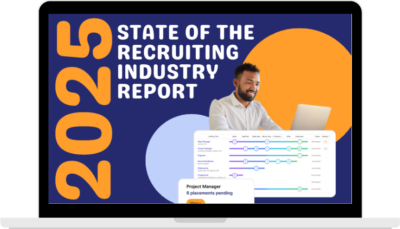(Editor’s note: The information from this article by Top Echelon Recruiting Software has been taken from an Expert Recruiter Coaching Series webinar by Greg Doersching of Next Level Training titled, “Cultivating a Growth Mindset to Make More Placements” Click HERE to watch the video of that training webinar for free.)
In the fast-paced, competitive world of recruiting, your mindset can be your greatest asset—or your biggest liability. Success doesn’t just hinge on strategy, skill, or scripts. It’s about how you think, how you react to setbacks, and how willing you are to grow.
In a recent Top Echelon webinar, veteran recruiting trainer Bob Marshall delivered a powerful session titled “Cultivating a Growth Mindset”, where he challenged recruiters to look inward—to confront their habits, routines, and the beliefs that may be capping their potential.
“Your positive outlook is critical to your success,” Marshall emphasized. “Winners win because the marketplace loves a winner.”
This article dives deep into Bob’s teachings and offers actionable insight to help you build the mental muscles necessary to become a top biller.
The Power of Mindset in a Competitive Market
Bob began by referencing Seth Godin’s The Dip, underscoring the idea that being the best in your niche is wildly more valuable than simply being competent.
“Few of us realize that the rewards for the winners are so heavily skewed,” Bob noted. “The number one producer can generate ten times the production of number ten, and 100 times that of number 100.”
This isn’t just motivational fluff—it’s Zipf’s Law in action. In recruiting, the top performers reap disproportionate rewards because the market rewards excellence, not effort.
Which begs the question: Are you aiming to be the best in your niche—or just trying to survive?
Understanding ‘The Dip’ and When to Pivot
Every recruiter eventually hits a plateau. Bob refers to this as “the dip”—that moment when things stop working like they used to.
“It’s the journey from novice to master,” he said. “From beginner’s luck to genuine achievement.”
The danger? Misidentifying a dip as a dead end. A dip is temporary and demands grit. A cul-de-sac, however, is a dead zone where no amount of effort will yield results.
That’s where opportunity cost enters the equation. Every minute you spend trying to revive a dying client relationship or fill an unfillable job order is a minute lost from something more promising.
“Sometimes good keeps you from great,” Bob warned. “You’ve got to quit your deadest tactics. Free up your resources and redirect them at something worth conquering.”
The market doesn’t reward effort. It rewards focus. And growth starts with strategic quitting.
Strategic Quitting: Not Failure—Focus
We’ve all heard “winners never quit.” But Bob turns that on its head.
“Winners do quit,” he said. “They quit the wrong things so they can persevere with the right things.”
Quit when:
-
You’ve settled for mediocrity.
-
Your effort isn’t yielding improvement.
-
The opportunity cost outweighs the benefit.
This isn’t giving up. It’s a redirection toward excellence.
“Average is not an option,” Bob stated. “Don’t settle. Strive for excellence or strategically quit to redirect efforts toward greater success.”
Even the legendary military figure O.P. Smith agreed: “We’re not retreating, we’re just advancing in a different direction.”
The Woodpecker Analogy: Stop Tapping 1,000 Trees
When things stop working, recruiters tend to panic. They diversify, try trendy tactics, or chase shiny new tools.
“But true success favors those who obsessively focus,” Bob explained. “Tapping 20 times on a thousand trees may yield nothing. But tapping 20,000 times on one tree ensures a meal.”
As John Wooden famously said, “Never mistake activity for achievement.”
If you’re dabbling in a dozen directions, you’re not growing—you’re flailing.
The Dog on the Nail: Why We Tolerate Discomfort
Bob tells a story about a dog sitting on a nail. The dog moans, day after day, but doesn’t move.
When asked why, the owner says, “It just doesn’t hurt enough yet.”
“Why don’t we quit painful situations?” Bob asks. “Because for most of us, it just doesn’t hurt that much yet.”
That’s a damning insight. Many recruiters stay stuck with bad clients, lazy habits, or inefficient systems simply because the pain hasn’t outweighed the inertia. A growth mindset doesn’t wait for the pain to build—it moves proactively.
Habits: The Hidden Drivers of Placement Success
After downturns or recessions, bad habits often sneak in. As things get chaotic, we stop doing what works. We take shortcuts. We let discipline slip.
Bob challenges recruiters to rebuild their atomic habits—the small, consistent actions that lead to exponential results.
“Every single qualification for success is acquired through habit,” he quoted from Albert Gray. “People form habits, and habits form futures.”
A recruiter’s day-to-day life is either built on good habits—or bad ones. Are you chasing every job order? Responding to unqualified candidates? Spending time on LinkedIn instead of the phone? Those are habits.
The good news: habits can be changed.
Focus on Systems, Not Goals
Bob emphasized that goals aren’t what make you successful—systems are.
“If setting a goal was enough, then every Olympian would win a gold medal,” he said. “Fix the inputs, and the outputs will fix themselves.”
This is the core of the atomic habit framework: make your habits obvious, attractive, easy, and satisfying. That’s how you create lasting change—and lasting billing power.
Concentration: Lessons from a Fighter Pilot
Bob shared a coaching story involving a recruiter who previously served as a U.S. Navy fighter pilot. The pilot said that landing on an aircraft carrier required focusing on just five things—no distractions, no improvising.
Bob adapted that to recruiting. There are six things top recruiters must focus on:
-
Activities that lead to money.
-
Picking up the phone.
-
Crafting powerful messaging.
-
Making multiple quality presentations daily.
-
Working high-value job orders only.
-
Tracking performance and ratios.
But ultimately, there are four areas you have full control over:
-
Your attitude
-
Your call volume
-
Your professional development
-
Your planning and tracking
Master those, and you’re in control of your destiny.
Willpower: A Habit You Can Build
Willpower isn’t infinite—but it is renewable.
Bob shared how Starbucks invests 50+ hours training new employees on willpower and self-discipline. Why? Because studies prove it’s the #1 keystone habit for success.
“Sometimes it looks like people with great self-control aren’t working that hard,” Bob said. “But that’s because they’ve made it automatic.”
Willpower has a battery life. Use it in the morning on your most important tasks—the ones that make you money. Don’t waste it replying to emails or scrolling job boards.
Client and Candidate Triage: Stop Chasing Ghosts
Bob was clear: disengaged clients and ghosting candidates are a huge waste of time. Recognize the signs early and pivot.
“Never quit a market or niche,” he advised. “But you can quit bad clients. Dead-end job orders. Uncooperative candidates.”
He introduced the idea of setting “drop-dead dates.” If you don’t see movement or progress by a set point, cut bait and move on. Make this decision early—before emotions cloud your judgment.
Amelia’s Story: Letting Go to Level Up
Bob shared a case study of Amelia, a recruiter who kept chasing clients that looked good on paper but never followed through.
Eventually, she made the call: she dropped them.
“It was tough,” Bob said, “but it freed up her bandwidth. She re-focused. And she became a big biller.”
Moral of the story? You can’t scale with dead weight. Trim your pipeline of fluff. Invest in clients and candidates who are serious.
When to Stop Beating a Dead Horse
Bob has a full presentation titled “The Dead Horse” that he referenced briefly. But in this session, he summarized it with a brutal truth:
“Stop beating a dead horse when you can say to yourself: ‘This deal is unworkable on my terms, and I’m not going to spend any more of my straight commission time on it.’”
Top 5 signs of a dead horse:
-
Incomplete info from clients or candidates.
-
Weak pre-closing techniques.
-
Ghosting or non-cooperation.
-
Hope sheets instead of hot sheets.
-
No clear buying signals from the employer.
Be ruthless with your time. You only get paid on the finish line—not the journey.
Blue Ocean Strategy: Fish Where No One Else Is Fishing
Finally, Bob introduced the powerful concept of Blue Ocean vs. Red Ocean strategies.
Red oceans are saturated markets with too many recruiters fighting for the same roles. Fees shrink. Margins disappear. Everyone is the same.
Blue oceans, however, are uncontested market spaces where innovation and specialization rule. Here, fees are higher. Clients see you as a partner—not a vendor.
“Approach your clients at the highest level,” Bob urged. “If you go to the President, you’re treated like a President. If you go to HR, you’re treated like a clerk.”
Recruiters who apply blue ocean thinking:
-
Specialize deeply in a niche.
-
Enter through leadership, not HR.
-
Offer unique, non-commodity services.
That’s how you rise above the noise.
Final Thought: You Don’t Have to Outrun the Bear
Bob wrapped up the session with a story. Two hunters are running from a bear. One stops to put on his track shoes.
The other says, “You can’t outrun a bear!”
The first replies, “I don’t have to outrun the bear. I just have to outrun you.”“You don’t have to do everything,” Bob concluded. “Pick the few ideas that resonate with you—whether it’s the dead horse, the blue ocean, or Amelia’s story—and act on them.”
Because in recruiting, small changes—made consistently—build into massive success.
Want More?
Bob Marshall’s full training program, Elite Recruiter Master Class, is available through TBMG and Top Echelon’s webinar library. Reach out to Bob at 770-898-5550 to learn more.
Change your habits. Change your outcomes. Make more placements.
Let me know if you’d like this turned into a blog format, PDF, email campaign, or even a slide deck!









